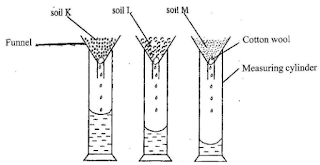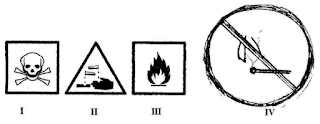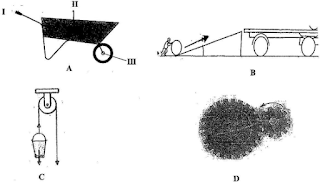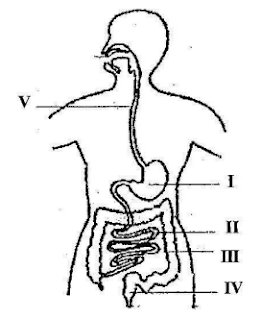BECE 2016 Integrated Science Paper 2 Essay
BECE Past Questions and Answers
BECE 2016 Integrated Science Paper 2
Essay
1 ¼ hour
This paper is in two parts: I and II. Answer Question 1 in part I and any other four questions in Part II
This paper is in two parts: I and II. Answer Question 1 in part I and any other four questions in Part II
PART I (40
marks)
Answer all of Question 1
1. (a) The funnels in the diagram below contain equal amounts of different types of soils labelled
K, L and M. Equal volumes of water were poured onto each soil at the same time and
allowed to drain for 20 minutes.
Study the diagram and answer the questions that follow
(i) What is the aim of the experiment?
(ii) Which soil has the highest rate of drainage?
(iii) Which soil has the highest water retention capacity?
(iv) Which soil is most likely to lose water and dry faster after rainfall?
(v) Which soil is most likely to be waterlogged after rainfall?
(vi) Which of the soil types would be suitable for maize cultivation?
(ii) Which soil has the highest rate of drainage?
(iii) Which soil has the highest water retention capacity?
(iv) Which soil is most likely to lose water and dry faster after rainfall?
(v) Which soil is most likely to be waterlogged after rainfall?
(vi) Which of the soil types would be suitable for maize cultivation?
(b) The
diagram below illustrates hazard symbols labelled I, II, III and IV.
Study the diagram carefully and answer the questions that follow.
Study the diagram carefully and answer the questions that follow.
(i).
What does each of the symbols labelled I, II, III and IV represent?
(ii) Name one substance
each that is associated with:
(α) I
(β) II
(y) III
(iii) Name a place where the hazard symbol labelled IV is often
displayed.
(iv) Which of the symbol is/are found on chemical containers?
The diagrams below are illustrations of devices used to do work
easily
Study the diagrams and answer the questions that follow
Study the diagrams and answer the questions that follow
(i)
Give a general name for the devices?
(ii)
Identify each of the devices labelled
A, B, C, and D.
(iii)
Name the parts labelled I, II and III of
device A when it is considered as a lever.
(iv)
What does the arrow represent in the
device labelled B?
(v)
Name the type of work done with each of
the devices labelled:
(α) C;
(β) D;
(d) The diagram below
illustrates the digestive system in humans.
Study the
diagram carefully and answer the questions that follow.
(i)
Name each of the parts
labelled I, II, III, IV and V.
(ii)
Name the part(s) of the
digestive where
(α) digestion of food
substances occur
(β) digested food is absorbed
into the bloodstream
(iii)
Name the end-products of the
digestion that is absorbed into the bloodstream.
PART II (60
marks)
Answer four questions only from this section
2. (a) Name four weather measuring instruments.
(b) Name the
stages in the life cycle of a mosquito.
(c) (i) List two properties of water.
(ii) Explain why it is advisable to wash
clothes with softwater.
(d) State three
ways in which soil profile is important.
3. (a) List three modes of heat transfer.
(b) (i) What is a deficiency disease?
(ii) Name
three deficiency diseases in humans.
(c) State two ways in which each of
the following factors cause depletion of soil resources:
(i) burning
(ii) leaching
(i) burning
(ii) leaching
(d) List three
processes that can change matter from one state to another.
4. (a) (i) What is a
satellite?
(ii) Give three uses of artificial
satellites.
(b) State the composition of each of the
following alloys:
(i) brass
(ii) steel
(iii)
Bronze
(c.) Name three cultural practices used
in vegetable production.
(d) List four parts of the respiratory
system in humans.
5. (a) (i) What is a force?
(ii) State two ways in which
forces could affect a body?
(b) (i) What is a chemical change?
(ii) State three differences between chemical change and physical change.
(ii) State three differences between chemical change and physical change.
(c) Name three physical properties of soil.
(d) Mention three diseases of the
circulatory system in humans.
6. (a) Write
the systematic name for each of the following compounds:
i.
H2O
ii.
MgO
iii.
CaO
iv.
CaCl2
(b) Name the instrument used in measuring
the following:
i.
Length of a robe
ii.
Mass of a stone
iii.
Temperature of a liquid
iv.
Volume of a liquid
(c.) List
three factors that influence vegetable crop production.
(d) Name four
stages in the life cycle of a flowering plant.
You Might Also Like
bece 2020 questions and answers
bece
2016 questions and answers
bece past questions pdf download






.webp)








No comments: